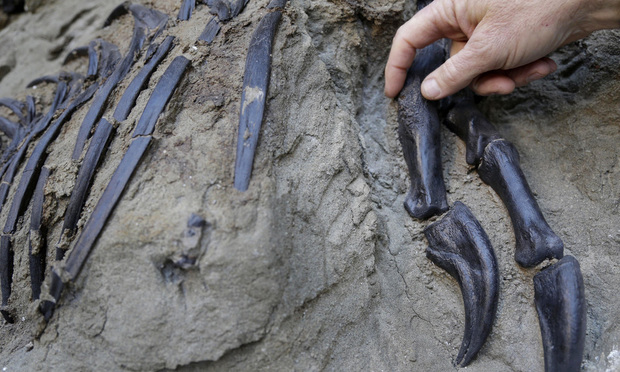Daily Dicta: Dinosaur Fossil Fight Goes Extinct at Ninth Circuit
The case presented an issue of first impression in Montana: Are dinosaur fossils minerals? It's a seemingly straightforward question with no clear answer.
May 21, 2019 at 12:40 PM
6 minute read
 In this Thursday, Nov. 14, 2013 photo, Clayton Phipps points out some features of the nanotyrannus lancensis he discovered, while the fossils are on display in New York. Two fossilized dinosaur skeletons found on a Montana ranch in 2006 are coming up for sale in New York City. The nearly complete skeletons are billed as the Montana Dueling Dinosaurs. (AP Photo/Seth Wenig)
In this Thursday, Nov. 14, 2013 photo, Clayton Phipps points out some features of the nanotyrannus lancensis he discovered, while the fossils are on display in New York. Two fossilized dinosaur skeletons found on a Montana ranch in 2006 are coming up for sale in New York City. The nearly complete skeletons are billed as the Montana Dueling Dinosaurs. (AP Photo/Seth Wenig)
For every lawyer asked by a 7-year-old, “What do you do at work?” this is what you wish you could answer: Fight over the fossils of two giant dinosaurs locked in mortal combat and entombed in sandstone 66 million years ago.
You might recall Lit Daily's previous coverage of the dispute between the current and former owners of a Montana ranch where the remains of the “dueling dinosaurs” —a 22-foot-long theropod and a 28-foot-long ceratopsian—were discovered, along with a complete T-Rex skeleton and a large Triceratops skull. The fossils are worth millions of dollars.
On Monday, the U.S. Court of Appeals for the Ninth Circuit ruling en banc punted the fight to the Montana Supreme Court.
“Because of the importance of the state law question, and the potential of different outcomes in federal and state courts, we have elected to certify the issue to the Montana Supreme Court,” wrote Chief Judge Sidney Thomas, joined by 10 colleagues on the bench—who have now collectively lost their claim to coolness among the pre-K and elementary school set.
The case presented an issue of first impression in Montana: Are dinosaur fossils minerals? It's a seemingly straightforward question with no clear answer—and implications that go beyond the immediate private contractual dispute.
As a group of paleontology associations and natural history museums represented by Covington & Burling's Gary Guzy and Pooja Kothari put it in an amicus brief, the decision could “destabilize title to countless important fossils in academic, museum, and private collections around the world.”
 The fight began after Lige and Mary Ann Murray in 2005 bought a ranch in Garfield County, Montana from Jerry and Robert Severson. The Murray's purchase included the surface estate and one-third of the mineral estate. (Apparently in Montana, it's common to sever a property's mineral rights from its surface ownership.)
The fight began after Lige and Mary Ann Murray in 2005 bought a ranch in Garfield County, Montana from Jerry and Robert Severson. The Murray's purchase included the surface estate and one-third of the mineral estate. (Apparently in Montana, it's common to sever a property's mineral rights from its surface ownership.)
The Seversons expressly retained the remaining two-thirds of the ranch's mineral rights, which now belong to commercial extraction companies BEJ Minerals and RWTF, represented by Brian Lake and Shane Swindle of Perkins Coie. (The companies had been represented by Eric Miller at the firm until he was confirmed to the Ninth Circuit in February.)
All the parties agree no one was thinking about fossils when they made the deal, but a few months later, the Murrays started discovering the ancient remains of dinosaurs on the land.
In 2014, they sought a declaratory judgment that they were the sole owners of the fossils. The extraction companies filed a counterclaim asserting that the fossils are properly classified as minerals, which would mean they'd own two-thirds of them.
The Murrays, represented by Harlan Krogh and Eric Nord, Crist of Krogh & Nord, won before U.S. District Judge Susan Watters in Montana, but in November, a divided Ninth Circuit panel reversed Watters and held that fossils are indeed minerals.
“Although it could be argued that dinosaur fossils are unlike oil, gas, coal, and other substances traditionally thought of as minerals because they are not used as fuel, neither are many of the other substances specifically listed in the Webster's definition, such as salt, sand, and gravel,” wrote U.S. District Judge Eduardo C. Robreno of the Eastern District of Pennsylvania, sitting by designation. He was joined in the majority by Judge Milan D. Smith, Jr.
“In addition,” Robreno continued, “oil, gas, and coal all derive from the remains of plants and animals, just like dinosaur fossils, and should not be treated any differently because they are valuable for a different reason.”
The decision was greeted with dismay by leading paleontologists and museums. First of all, they noted in their amicus brief, fossils aren't even minerals in the scientific sense. “Because fossils were initially formed through biological rather than geological processes, established scientific understanding holds that dinosaur fossils are not minerals,” the Covington team wrote.
“The panel also haphazardly applied a legal test designed to identify the subset of all minerals that a mineral deed would reserve,” they continued. “It focused only on whether these fossils are 'rare and exceptional' and possess 'special value,' concluding that the Montana Fossils are minerals because they meet these criteria. In fact, the mineral content of fossils has little value because it is common; the fossils' value derives from the biological information they convey about ancient life.”
The United Property Owners of Montana sounded the alarm as well. “[L]iterally untold tens of thousands of fossils have been transferred, sold and otherwise controlled and disposed of by owners of the fee title (surface estate), without regard to the separate and distinct interests of the owners of the mineral estate. This is well settled custom and practice across Montana, without a single outlier, until the panel's 2-1 decision,” wrote Colleen M. Dowdall of Dowdall Law in an amicus brief.
Dowdall argued that fossils fall under the law governing the taking of live wild animals, or ferae naturae.
Surface property owners in Montana “as a matter of law control who can access private land and take wild animals ferae naturae. It easily follows that the death of such creatures causes no change in the legal status of who controls their remains, no matter how old, nor what biological processes may occur in the interim.”
Ultimately, the Ninth Circuit may have felt it had little choice but to send the case back to Montana. On April 16, Montana Governor Steve Bullock signed into law a bill declaring that dinosaur “fossils are not minerals and that fossils belong to the surface estate”—which should shut down future disputes.
The Ninth Circuit did note that the new law does not affect proceedings in court before it took effect. Still, it would have been problematic if they reached an opposite conclusion from state lawmakers.
So alas, it's back to ERISA and immigration and prisoner appeals for the appellate judges—the dino case, at least for them, is extinct.
This content has been archived. It is available through our partners, LexisNexis® and Bloomberg Law.
To view this content, please continue to their sites.
Not a Lexis Subscriber?
Subscribe Now
Not a Bloomberg Law Subscriber?
Subscribe Now
NOT FOR REPRINT
© 2025 ALM Global, LLC, All Rights Reserved. Request academic re-use from www.copyright.com. All other uses, submit a request to [email protected]. For more information visit Asset & Logo Licensing.
You Might Like
View All
After a Wild 4-Year Ride, Wilson Sonsini Duo Has $136M in Proof that Foreign Bribery Isn't a Victimless Crime

Litigator of the Week: $1B Jury Verdict for Davis Wright Tremaine's Di Lorenzo

Daily Dicta: Sheppard Mullin Goes Fishing for Justice
Trending Stories
- 1No Two Wildfires Alike: Lawyers Take Different Legal Strategies in California
- 2Poop-Themed Dog Toy OK as Parody, but Still Tarnished Jack Daniel’s Brand, Court Says
- 3Meet the New President of NY's Association of Trial Court Jurists
- 4Lawyers' Phones Are Ringing: What Should Employers Do If ICE Raids Their Business?
- 5Freshfields Hires Ex-SEC Corporate Finance Director in Silicon Valley
Who Got The Work
J. Brugh Lower of Gibbons has entered an appearance for industrial equipment supplier Devco Corporation in a pending trademark infringement lawsuit. The suit, accusing the defendant of selling knock-off Graco products, was filed Dec. 18 in New Jersey District Court by Rivkin Radler on behalf of Graco Inc. and Graco Minnesota. The case, assigned to U.S. District Judge Zahid N. Quraishi, is 3:24-cv-11294, Graco Inc. et al v. Devco Corporation.
Who Got The Work
Rebecca Maller-Stein and Kent A. Yalowitz of Arnold & Porter Kaye Scholer have entered their appearances for Hanaco Venture Capital and its executives, Lior Prosor and David Frankel, in a pending securities lawsuit. The action, filed on Dec. 24 in New York Southern District Court by Zell, Aron & Co. on behalf of Goldeneye Advisors, accuses the defendants of negligently and fraudulently managing the plaintiff's $1 million investment. The case, assigned to U.S. District Judge Vernon S. Broderick, is 1:24-cv-09918, Goldeneye Advisors, LLC v. Hanaco Venture Capital, Ltd. et al.
Who Got The Work
Attorneys from A&O Shearman has stepped in as defense counsel for Toronto-Dominion Bank and other defendants in a pending securities class action. The suit, filed Dec. 11 in New York Southern District Court by Bleichmar Fonti & Auld, accuses the defendants of concealing the bank's 'pervasive' deficiencies in regards to its compliance with the Bank Secrecy Act and the quality of its anti-money laundering controls. The case, assigned to U.S. District Judge Arun Subramanian, is 1:24-cv-09445, Gonzalez v. The Toronto-Dominion Bank et al.
Who Got The Work
Crown Castle International, a Pennsylvania company providing shared communications infrastructure, has turned to Luke D. Wolf of Gordon Rees Scully Mansukhani to fend off a pending breach-of-contract lawsuit. The court action, filed Nov. 25 in Michigan Eastern District Court by Hooper Hathaway PC on behalf of The Town Residences LLC, accuses Crown Castle of failing to transfer approximately $30,000 in utility payments from T-Mobile in breach of a roof-top lease and assignment agreement. The case, assigned to U.S. District Judge Susan K. Declercq, is 2:24-cv-13131, The Town Residences LLC v. T-Mobile US, Inc. et al.
Who Got The Work
Wilfred P. Coronato and Daniel M. Schwartz of McCarter & English have stepped in as defense counsel to Electrolux Home Products Inc. in a pending product liability lawsuit. The court action, filed Nov. 26 in New York Eastern District Court by Poulos Lopiccolo PC and Nagel Rice LLP on behalf of David Stern, alleges that the defendant's refrigerators’ drawers and shelving repeatedly break and fall apart within months after purchase. The case, assigned to U.S. District Judge Joan M. Azrack, is 2:24-cv-08204, Stern v. Electrolux Home Products, Inc.
Featured Firms
Law Offices of Gary Martin Hays & Associates, P.C.
(470) 294-1674
Law Offices of Mark E. Salomone
(857) 444-6468
Smith & Hassler
(713) 739-1250







